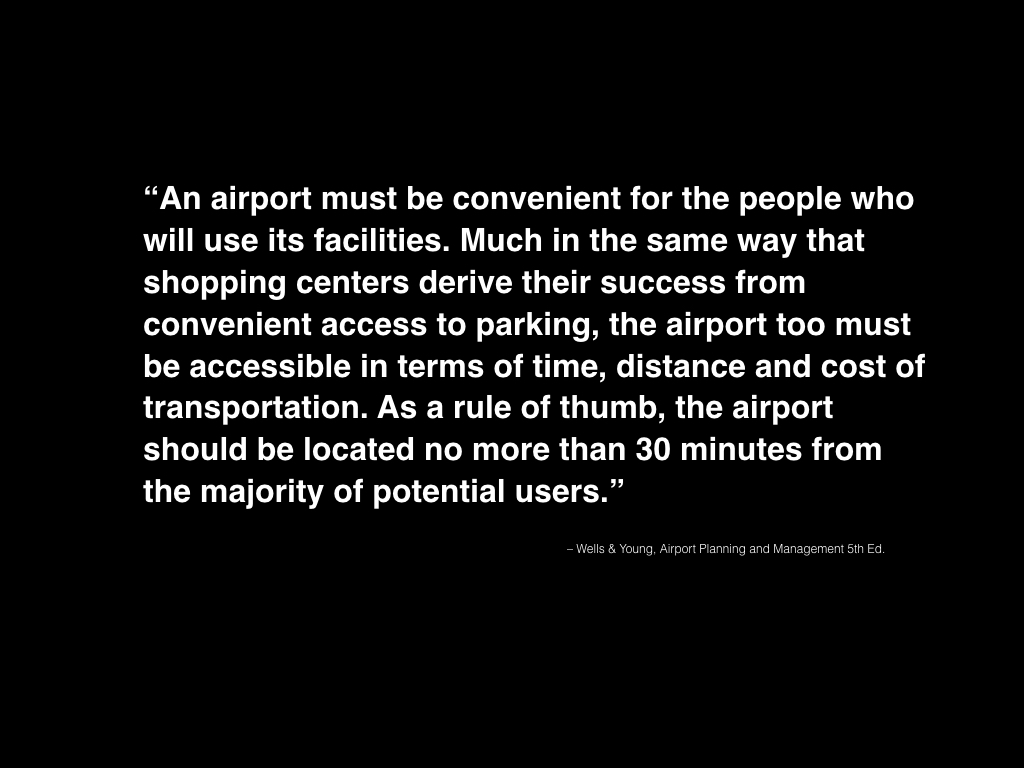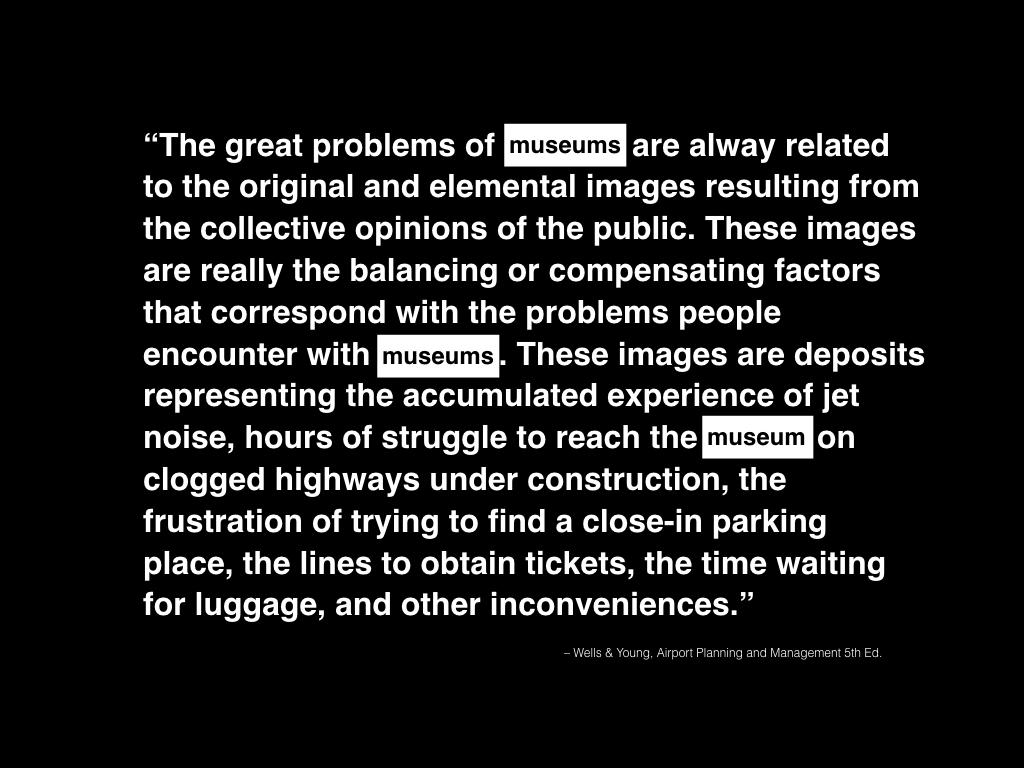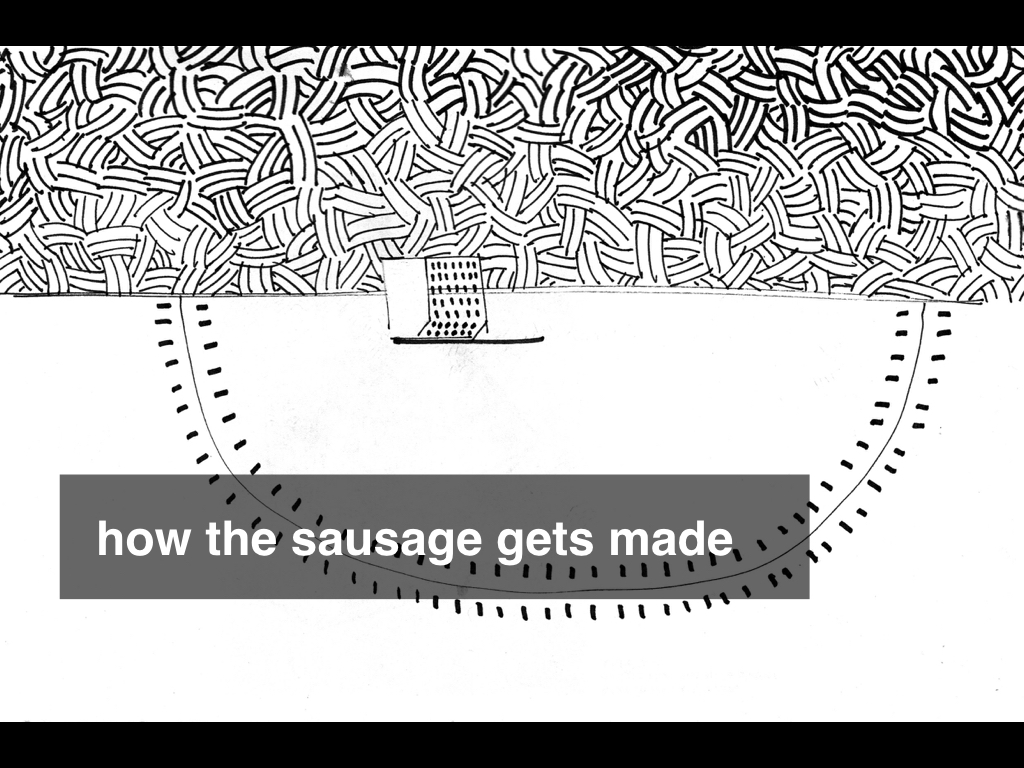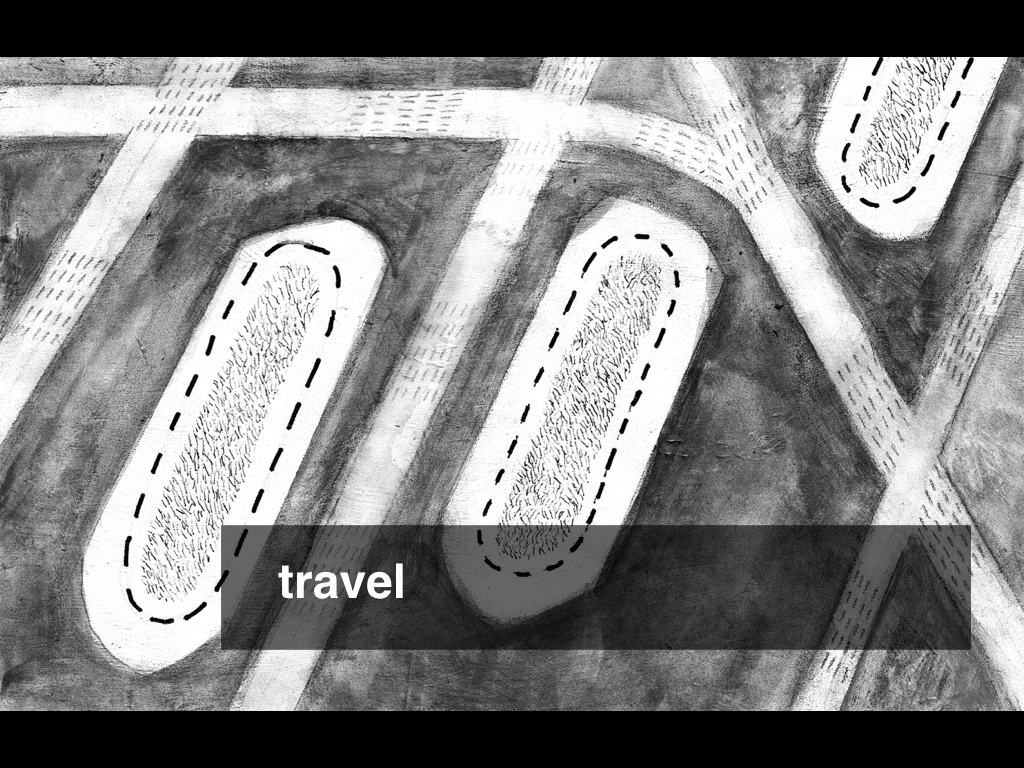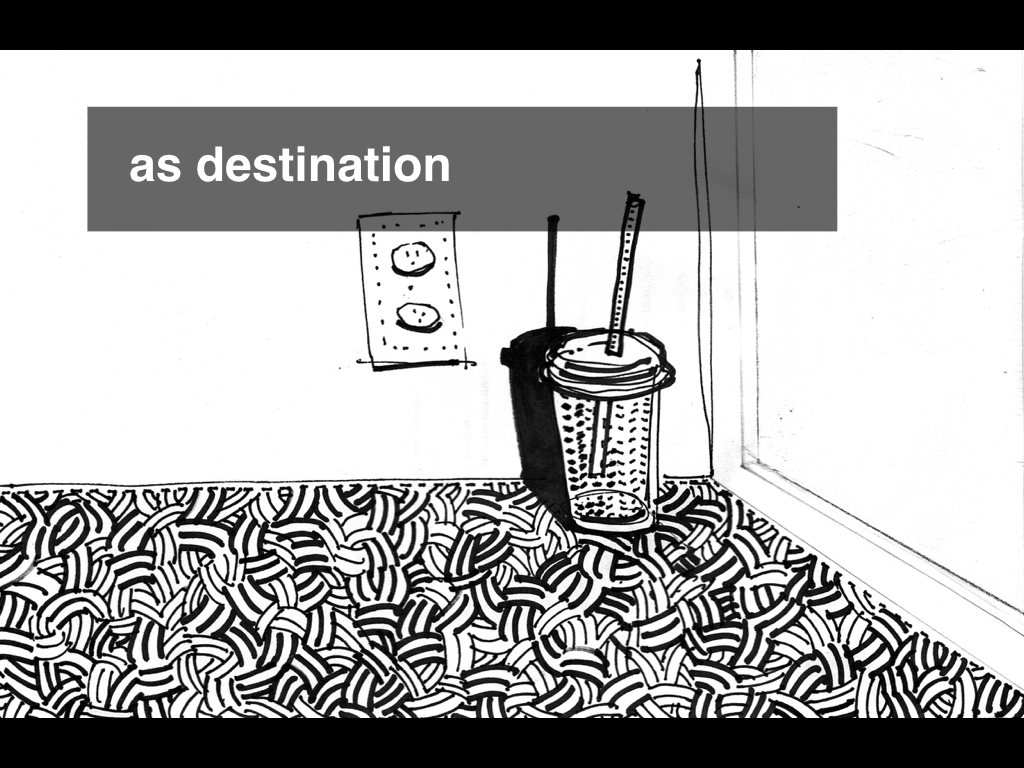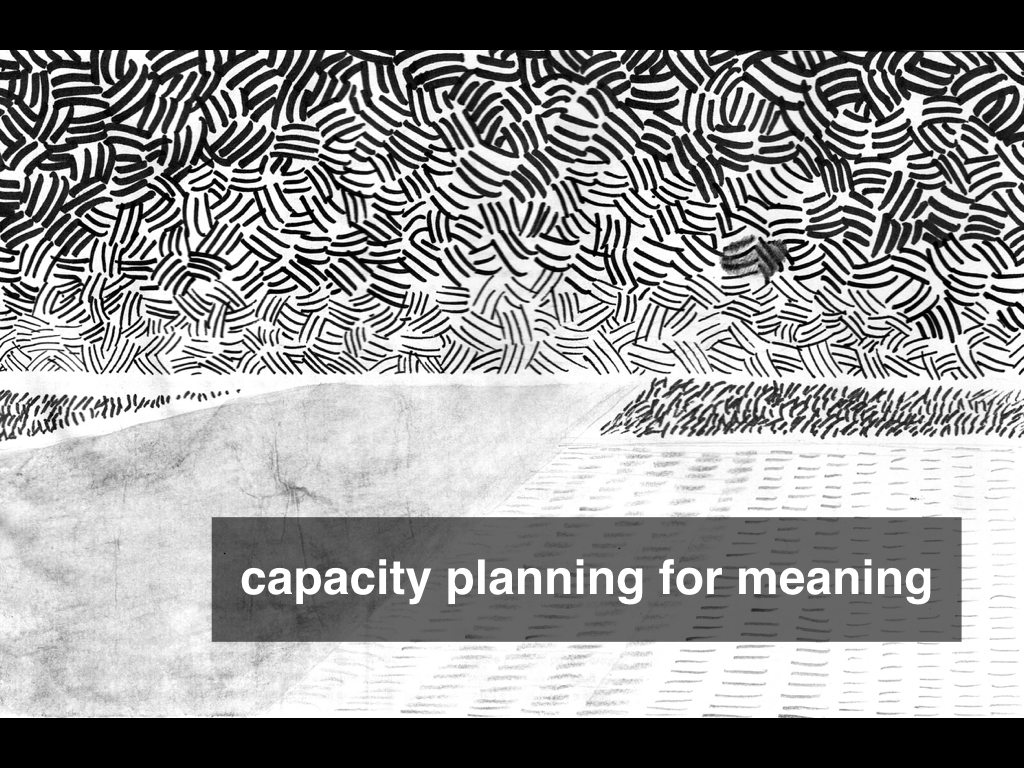henry moore on the runway
These are the slides and notes from a talk I delivered at the Museum Computer Network conference, last week. The original title of the talk was Let's Move All the Museums Out to the Airport (or, at Least Just the Smithsonian)
. I tweaked the title shortly before doing the talk after telling a friend about the Henry Moore room at the Art Gallery of Ontario and started imagining using the grassy spaces between the runways and taxiways at airports as places for large sculpture installations.
This is what I said.
I'd like to start by playing a little game. The following is a passage from the fifth edition of Airport Planning and Management:
An airport must be convenient for the people who will use its facilities. Much in the same way that shopping centers derive their success from convenient access to parking, the airport too must be accessible in terms of time, distance and cost of transportation. As a rule of thumb, the airport should be located no more than 30 minutes from the majority of potential users.
Or this:
A museum must be convenient for the people who will use its facilities. Much in the same way that shopping centers derive their success from convenient access to parking, the museum too must be accessible in terms of time, distance and cost of transportation. As a rule of thumb, the museum should be located no more than 30 minutes from the majority of potential users.
See what I did there?
Here is another passage:
The great problems of airports are alway related to the original and elemental images resulting from the collective opinions of the public. These images are really the balancing or compensating factors that correspond with the problems people encounter with airports. These images are deposits representing the accumulated experience of jet noise, hours of struggle to reach the airport on clogged highways under construction, the frustration of trying to find a close-in parking place, the lines to obtain tickets, the time waiting for luggage, and other inconveniences.
Again:
The great problems of museums are alway related to the original and elemental images resulting from the collective opinions of the public. These images are really the balancing or compensating factors that correspond with the problems people encounter with museums. These images are deposits representing the accumulated experience of jet noise, hours of struggle to reach the museum on clogged highways under construction, the frustration of trying to find a close-in parking place, the lines to obtain tickets, the time waiting for luggage, and other inconveniences.
Okay, museums don't have the problem of jet noise but otherwise it sounds about right:
The great problems of museums are alway related to the original and elemental images resulting from the collective opinions of the public. These images are really the balancing or compensating factors that correspond with the problems people encounter with museums. These images are deposits representing the accumulated experience of ... noise, hours of struggle to reach the museum on clogged highways under construction, the frustration of trying to find a close-in parking place, the lines to obtain tickets, the time waiting for luggage, and other inconveniences.
Hi, my name is Aaron.
For those of you I've not met before I used to be the guy who would swoop in from 50, 000 feet to this and other museum conferences, once or twice a year, waving my arms around talking about the Internet and then I would depart just as quickly leaving everyone else in the room to do the hard work for the rest of the year.
More recently I was part of the Digital and Emerging Media team at the Cooper Hewitt, in New York City. I helped to make the Pen and all of the backend systems that run the digital experiences at the museum. Since then I have moved back to the West Coast and now I am that guy who swoops in from 50, 000 feet again.
Today I want to talk to you about airports and museums. I want to talk about this idea of moving museums out to airports because, on some very practical levels, I think our sector has a lot to learn from their sector. I also want to talk about the idea, whether or not it comes to pass, because it forces some larger issues that the museum sector doesn't always like to talk about but needs to.
So, museums.
At least from the perspective of a visitor I think the new Whitney Museum in New York has the best museum architecture in play today.
Like most new museums it has a signature Big Honking Elevator, that can house three or four dozen people at a time, running up and down its central core. The elevator takes you up to the eigth floor and as soon as you exit your eyes are immediately drawn to an enormous floor to ceiling window overlooking the Hudson River.
After you've had a look around at the art you discover that there's a large outdoor terrace, with suitably New York sized views of Manhattan, and stairs down to the seventh floor. This happens once more between the seventh and sixth floors.
You need to take a bog-standard museum stairwell down to the fifth floor.
After looking at the art, again, you wander over the West wall which it turns out is really a baffle wall. Poking your head around the corner you discover that there is not just another floor to ceiling window but a floor to ceiling window that is the width of the entire room. Which is pretty impressive but what's even more impressive is that there is a line of couches set against the baffle all facing the windows. This is repeated on the East side of the museum.
Needless to say the couches are full of people.
The Whitney is not, outwardly, a beautiful building. Seen from the street it resembles nothing more than a handful of very large shapes placed next to each other without, seemingly, much thought or reason. There is no Gehry-esque whimsy or excess happening. It's just a series of primitive shapes stuck to one another at odd angles.
What I love about the Whitney is that is an elegant piece of functional architecture. Specifically it affords the visitor a chance to pause and catch their breath, a chance to step out of the forced march of Experiencing Culture long enough to see the sun or get some fresh air or even, yes, check their email. It allows them the chance to sit down.
When was the last time you sat down, outside of the coffee shop or restaurant, in a museum? In fairness I sat down in the nice chairs at MIA last night but they are still the exception...
So, airports.
Wednesday morning I was standing at SFO waiting to fly here to Minneapolis, for this conference. I managed to arrive with an hour to kill and do you know what I did? I walked from one terminal to another to go and see a painting by Wayne Thiebaud. Not a print, not a drawing, not an oil sketch. A full-on capital-P painting by a guy whose work may not command the pages of the New York Times come auction season but who your museum would absolutely take out insurance on.
When was the last time that happened?
A painting just hanging on the wall in between the entrance to the women's restroom and some over-priced artisanal smoothie place, facing the departures display.
When you tell people stories like this most of them will nod knowingly and say something like Oh yeah, SFO has a museum or something, doesn't it...
They are often thinking of the long stretch in Terminal 3, between security and the boarding gates, that is lined with plinths and display cases. Not many people could tell you what's in any of those cases but they all remember seeing wall labels so it must be a museum, right?
It's important to point out that this – museums and airports, airports and museums – is already happening.
The SFO Museum, owned and operated by the city of San Francisco, has an enormous permanent collection and upwards of two dozen gallery spaces spanning three separate terminals. The Rijksmuseum has long had a presence, albeit small and threatening in a high-design kind of way, at Schiphol airport in Amsterdam. The recently opened T2
terminal at the airport in Mumbai has a chief curator who has pledged to cover the place in Indian cultural artifacts. The airport in Taipei has a series of exhibition spaces curated by the city's various museums throughout its facilities.
The list goes on. The list of museums proper in airports may be short by standards but the list of airports with public art programs is long.
The list of museum shops in airports makes it all a bit more confusing. I don't want to talk about airport shops today except to say that if you exclude the people who are crazy enough to spend money in them, and you squint your eyes a little bit, you're left with a lot of people who look and behave an awful lot like people wandering around a museum.
Both museums and airports come in all sizes. There are lots of them (roughly seventeen thousand of each in the United States alone) and most are small and competing for resources gobbled up by a few big players. The big ones are flush with staff and the small ones are all staffed by people doing the jobs of three or four other people.
Outside of renovations shutting down, for even a short amount of time, is not an option for either. Just for kicks try asking someone from MoMA, or any of the big museums in New York City, what would happen if JFK were closed for two weeks.
Both are accredited and both have complicated relationships with concessionaires.
But consider the other concerns that museums share with airports. The need for:
- storage space
- space to house large objects
- space to inspect and repair those objects
- so-called
clean
rooms - space for large and heterogeneous groups of people
- visitor flow and crowd control
- seating
- security
- facilities for food and beverage
- toilets
- power and networking
- climate control systems
- shipping
- lighting and windows
- compliance with the Americans with Disabilities Act, or equivalent
- minimizing the distance between storage and display
All of which probably sounds pretty familiar, right?
And this is really the nut of what I am trying to get at. When we look at the needs and demands of most museums in 2015 maybe it's worth looking beyond our specifics and asking: Who is doing like-work, and doing it better, from whom we can learn?
For example, the distance between storage and display might seem like a museum-specific example until you remember the reason you can replace a lost credit card overnight is because your new card is literally printed at the airport and tossed on to the next plane destined for your hometown.
The details change but the dynamics are the same.
The point I am trying to make is that the buildings museums have and the buildings museums are designing don't work.
Current museum architectural practice is basically glorified window dressing and spectacle as a status symbol. There is an entirely other talk discussing the role and the function of trophy buildings as a proxy experience for the people who feel they're supposed come to museum but don't actually understand anything about the work on display, but this is not that talk.
We are bending over backwards in the service of over-priced and over-valued real-estate, monkey-patching everything in the process often at the expense of the very mission and purpose for which a museum exists.
The worst part of this practice, for me, is that we store and protect most of our collections in some of the most functional yet ugliest buildings ever built. Some of us even do the work of the museum in those same buildings. The kind you often see... at the airport.
One argument that I hear about the need for these very extravagant buildings and their locations is that museums need to be in the city center and sufficiently flashy in order to reach people. The corollary, conveniently for museums, is that by being in the city center they bestow upon it the warm fuzzy glow of cultural legitimacy.
Which is maybe still true if you haven't already been priced out of the center of most large urban areas.
It was faster for me to get to this hotel from the airport in Minneapolis by light-rail than it is for me to travel from Brooklyn to the Metropolitan Museum of Art in New York or the Cooper Hewitt where I used to work. Or from London's Hackney neighbourhood to that city's Science Museum in the West End. It is faster to get from Schiphol airport to the center of Amsterdam, by train, than it is to travel from one side of San Francisco to the other by practically any means of transportation.
Nearly every city in Europe already has a fast or high-speed train from the city center to the airport and both Canada and the United States are finally starting to catch up.
MONA, the Museum of Old and New Art in Hobart, runs it own suite of luxury apartments next to the museum complete with works from David Walsh's collection. You can already day-trip to MONA from Melbourne, traveling from airport to museum to airport without ever setting foot in the city of Hobart itself.
Sooner or later the old TWA terminal at JFK, designed by Eero Saarinen, will be converted in to a luxury hotel. I'd say it's even money whether it will happen in our lifetime but it will happen. Airports are becoming destinations in and of themselves.
Medical tourism where the facilities are inside of or adjacent to the airports is a real thing and once you've built out the infrastructure to manage those kinds of flows why restrain yourself to medicine? Why not a museum?
I travel more than most people and not nearly as much as others. I travel enough that I know airports by their reputation and by their features which increasingly means the artwork on display.
Wringing our hands about repeat visitation
is an old pass-time in the museum sector followed quickly by decrying people not spending enough time with any our works to truly experience their meaning and impact.
The opportunity of treating the airport as a museum is in the scores of people who travel for work and find themselves in the same airport, in the same terminal, week after week. What if those business travelers could spend the margins of their days, waiting to board an airplane, contemplating a single work of art on display near their gate rather than this week's hyperbolic print ad for yet another enterprise software platform?
This is the part of the talk where I am going to risk burning some bridges. I am going to say some things about the Smithsonian, for whom I used to work, that they may not want to hear or at least not want voiced in public.
It may seem like a non-sequitur, at first, but bear with me.
There is a proposal that the Smithsonian open a branch museum in East London as part of the redevelopment of the 2012 Olympic Park. This is reportedly a passion project for London's mayor Boris Johnson who has offered to foot the bill for the entire thing so no US tax-payer dollars will be spent to fund the endeavour.
What I am about to say may not be politic but I believe it is important that someone say it out loud and in public. Both as a former employee and as an average citizen: I think this is possibly the worst idea the Smithsonian has entertained in forever.
It smacks of vanity and self-aggrandizement. It strikes me as being both a distraction and waste of time for an institution that is already over-burdened where the only return is... a status symbol and more over-priced real-estate?
It is an exercise in "museum as brand" which whatever you think of the practice is the prerogative of private museums but is nothing short of offensive coming from a public institution.
The mission statement of the Smithsonian is the increase and furthering of knowledge
. Full-stop. There's nothing specific about the 300 million Americans in whose name the institution exists but let's assume they are the primary audience, at least for the sake of my argument.
There are lots of different ways to try and meet those goals but if we're going to argue that museum expansion is one of them it's hard to argue with the idea that the one place the Smithsonian should open a new museum in 2015 is... Las Vegas.
Whatever you think of the idea it is difficult to deny that Las Vegas is the intersection of most Americans these days.
Or Los Angeles. Or Phoenix, but like Las Vegas it's not clear that Pheonix will be sustainable as an urban center in the coming years. Maybe Chicago or Denver or Atlanta, even.
Really though, any place West of Virginia (which is roughly 70% of the United States) would be a good place for the Smithsonian to start to do outreach
.
Do you notice something about each one of those places I've mentioned? They are all hubs for the major airlines. It's not so much that everyone visits these places but they certainly all pass through their airports.
So why not just display the Smithsonian collection there? And not just the hub airports. All the airports. Seriously. I haven't done the math but I would wager that the sum total of available square footage for displaying objects spanning all the airports, large and small, across the United States dwarfs the entirety of The National Mall in Washington.
The Smithsonian has a 137 million objects in its collection. It could fill every large and mid-sized airport in the country without breaking a sweat or even taking anything off the walls in Washington. Rotating those objects between airports would be trivial, or at least imaginable.
Choosing to display museum objects at the airport is not without issues. Not least is the fact that many, many people still lack the time or the means to afford plane travel. On the other hand, according to a report published by the Federal Aviation Administraition earlier this year:
U.S. airlines served an estimated 756.3 million passengers in 2014, up by 2.3 percent from the 2013 level. The FAA forecast projects passenger growth to average 2.0 percent per year, reaching one billion passengers in 2029, and 1.14 billion by 2035.
That's just the United States so I'll leave as it an exercise for you to imagine how large those numbers become when you include the rest of the world.
One of the things that numbers like these suggest is that what little monies people do have is being spent on travel rather than the 30$ entrance fees which have come define visiting a museum these days.
Moving all the museums out to the airport is not something that's going to happen soon.
There is an enormous laundry list of operational details and concerns to work through. Just like museums, every airport is a special snowflake but when you look at places like SFO or Mumbai it's also clear that there is work to build on.
It would be expensive, too. Or rather it would be a large up-front capital cost, in both time and money. Then again, so are the buildings we've got and so are the buildings we want.
The issue is not that museum buildings have become an indulgence, which they have. In principle, I have no problem with an institution indulging itself. If you've got the money, knock yourself out. Have fun. The issue I have is that museum buildings have become an indulgence at the expense of the museum practice itself. They are overpriced luxuries that are inflexible and often incapable of adapting to change and that have outsized repercussions on the actual work that museums are supposed to be doing.
In many ways this is the same dynamic the museum sector struggles with around the questions of digital infrastructure, in-house development and third-party vendors made manifest in physical form and several orders of magnitude more expensive.
In abstract terms, this is about the speed and the cost with which the museum is able to adapt to change. In practical terms, it is about making the cost of proving or disproving a theory about how to manage that change so low that no one thinks twice about trying it.
I am not suggesting that museums become airports only that we may share more in common with them than we might think and that maybe we can learn something from them.
This blog post is full of links.
#mcn
